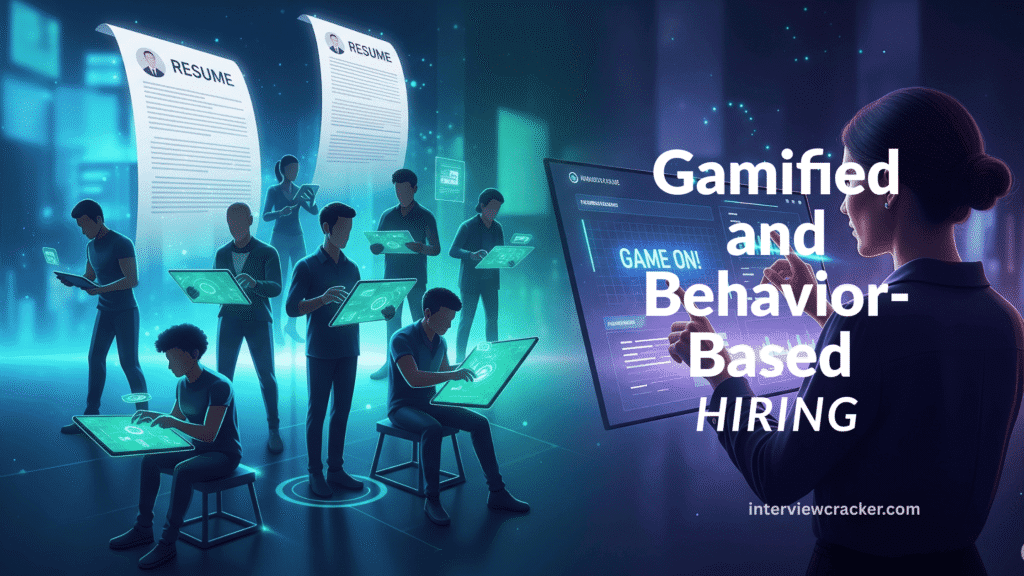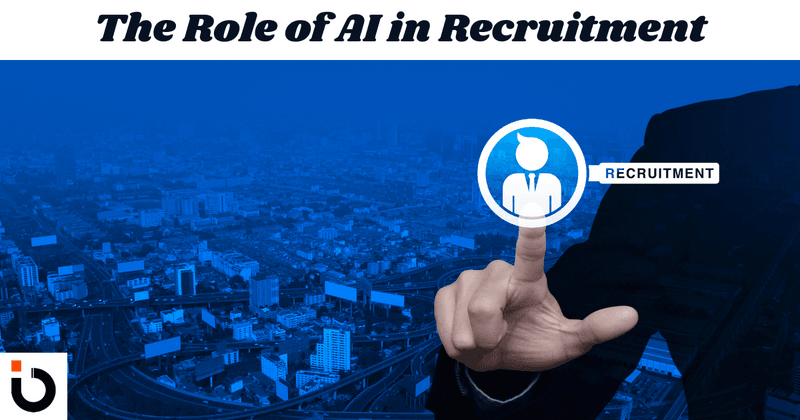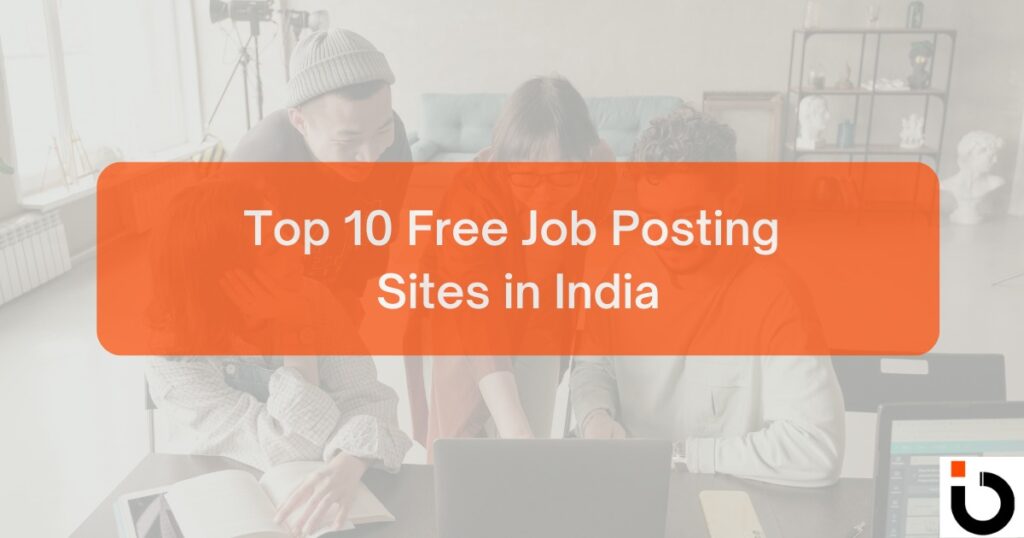Stop asking what potential hires know, but ask how they think.
This philosophy marks the shift from the traditional ways of looking at and assessing candidates based on resume and academic credentials in their history to what they know now: Their current skills and behaviour.
The way the most up-to-date hiring departments are doing so is through gamified assessments and behavioural simulations as part of more engaging and effective hiring workflows. This data gives hiring departments a more accurate picture of who will make their organization thrive by being productive while working effectively with others.
This article will show you the problems of traditional screening, how gamified hiring works, a definition of behaviour-based testing, and the role of enterprise AI.
Table of Contents
ToggleThe Problem with Traditional Screening
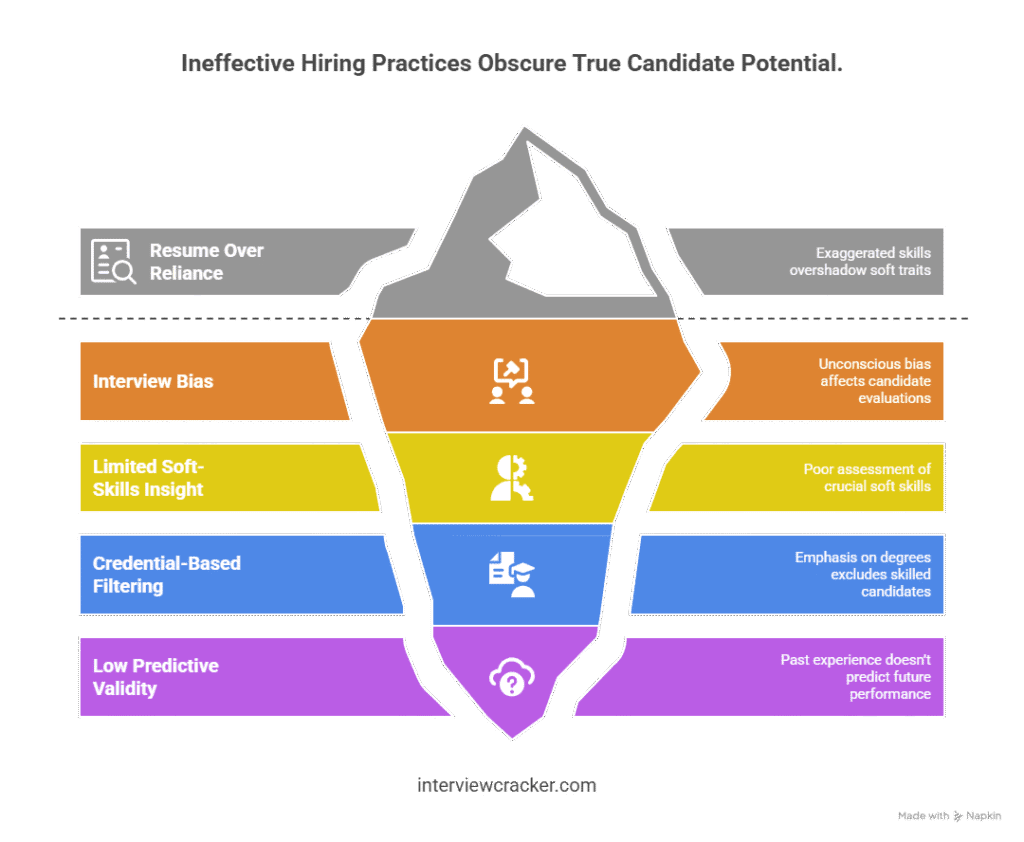
Traditional screening has several limitations:
- Over Reliance on Resumes: Resumes often exaggerate skills and miss important soft traits like adaptability, empathy, and collaboration.
- Bias in Interviews: Unstructured interviews introduce unconscious bias, affecting fairness and consistency across different candidate evaluations.
- Limited Soft-Skills Insight: Traditional methods poorly assess communication, problem-solving, and teamwork, crucial for modern, collaborative work environments.
- Credential-Based Filtering: Emphasis on degrees excludes capable candidates with practical skills gained through alternative or non-academic pathways.
- Low Predictive Validity: Past job titles and experience don’t reliably predict future job performance or cultural fit in roles.
The problem is that the legacy methods of assessment don’t collect the data necessary to establish if candidates will do the role well with their current skill sets and soft skills. This approach falls flat when candidates are applying for collaborative, dynamic, or leadership roles, which require high levels of soft skills that are hard to measure, like communication and leadership.
The answer to dynamic roles is a dynamic approach. Say hello to gamification, which creates a dynamic, realistic, and bias-resistant set of assessments that meet the needs of candidates and the organizations that need to find the best employees. Scroll down to see how it works.
How Gamified Hiring Works
It’s useful to be aware of the way all your processes work, especially if they are used to find the employees who can help your organization succeed.
What is Gamification in Hiring?
Gamification in hiring takes many forms, but it exists to assess candidates in a dynamic way to show potential employers a holistic view of their current skills, like soft skills and working well under pressure.
Related Read: Skill-Based Hiring
Gamified Assessments
Gamified assessments include:
- Simulations: Mimic real job tasks to assess behavior and decision-making.
- Decision-tree games: Evaluate responses through branching scenarios with real-time consequences.
- Time-based logic tests: Measure problem-solving speed and accuracy under timed conditions.
- Interactive personality quizzes: Gauge traits like empathy, curiosity, and risk tolerance interactively.
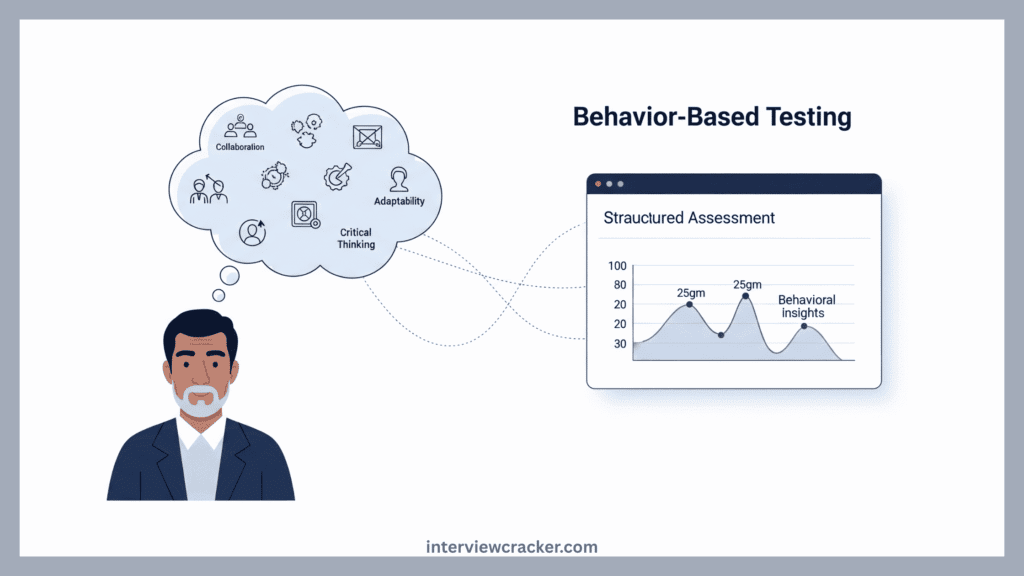
Choosing the Right Gamified & Behavioral Assessment Platform for Your Enterprise
Deciding to implement gamified and behavior-based testing is one thing; selecting the right HR technology solutions to make it happen is another. For enterprises, this isn’t a small decision, as the right pre-employment testing platforms need to integrate seamlessly, scale efficiently, and provide actionable data. Given the plethora of options, choosing wisely is crucial to maximize your ROI in talent acquisition.
When evaluating gamified assessment platforms and behavioral hiring software, consider these key features:
Scalability & Volume Handling: Can the platform effortlessly manage thousands of applicants simultaneously without performance degradation? Enterprise-level solutions must handle high recruitment volumes, ensuring a smooth experience for all candidates.
Seamless Integration Capabilities: A standalone tool is rarely enough. The best platforms offer robust APIs and pre-built integrations with your existing Applicant Tracking Systems (ATS) and Human Resources Information Systems (HRIS). This ensures data flows smoothly, reducing manual work and maintaining data integrity across your talent ecosystem. Look for strong integration partners.
Data Security & Compliance: Behavioral data is sensitive. Ensure the platform adheres to global data privacy regulations like GDPR, CCPA, and regional laws. Robust encryption, secure data storage, and transparent data handling policies are non-negotiable for enterprise deployments.
Customization & Branding: Can you tailor the assessments to reflect your company’s brand, culture, and specific role requirements? Customization ensures the assessments feel authentic and resonate with your target candidates, enhancing your employer brand.
Advanced Analytics & Reporting: Beyond raw scores, what insights does the platform provide? Look for features like predictive analytics for job success, bias detection tools, candidate benchmarking, and detailed reporting that can inform your strategic workforce planning.
Candidate Experience: While designed for assessment, the platform should still offer an intuitive, engaging, and mobile-friendly experience. A poor experience can lead to high drop-off rates and damage your reputation.
Leading providers in this space, such as Arctic Shores, Pymetrics, HireVue, Test Partnership, and Cangrade, offer varying strengths, from deep psychometric validation to highly customizable simulations. Researching and demoing these talent assessment tools will be a critical step in finding your perfect fit.
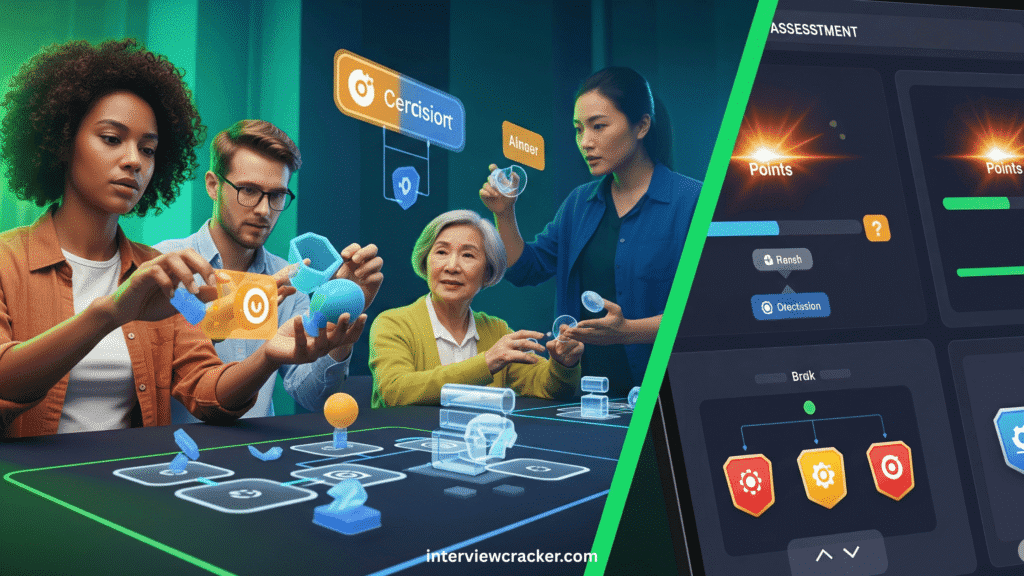
What Gamification Tools Exist?
There are numerous hiring gamification tools that assess various aspects of a candidate’s skills, including real-time decision-making, responding under stress, and exhibiting cognitive patterns. A few of the most popular tools include Arctic Shores, Pymetrics, and CodinGame.
How does Hiring Gamification Work?
in hiring works by testing candidates’ current skills through a series of assessments, such as simulations and time-limited questions, to evaluate their performance under stress and their ability to react to changing situations.
These tools engage candidates more actively, which can reduce the drop-off rate during hiring. It can also bring to the surface essential behavioural traits employers want, like adaptability, risk tolerance, and collaboration.
If candidates perform well on these dynamic tests, they get hired. It reduces bias too, which means a more diverse set of skills and fresh perspectives in the workplace, for higher innovation and wellbeing.
Enterprise AI and the Rise of Private AI in Hiring
AI is perfect for hiring gamification. AI can enhance gamified and behavioral assessments by doing what it does best: analysing large datasets across applicants, roles, and outcomes to offer dynamic experiences that test current skills.
Private AI is especially useful in hiring gamification because it uses enterprise-grade, secure AI systems that use a company’s data to find exactly what they need in candidates. It does this using hiring data, role definitions, and performance outcomes to find the perfect candidates.
These systems also ensure transparency, bias audits, and consent to build and maintain trust with candidates and regulators.
Measuring the ROI of Gamified Hiring and Behavioral Assessments
Adopting innovative recruitment methods like gamified and behavior-based assessments isn’t just about being cutting-edge; it’s about delivering tangible business value. Proving the ROI of gamified hiring and behavioral assessment software is essential for securing budget and demonstrating strategic impact to stakeholders.
Here are the key metrics and benefits to track to calculate your return on investment:
Reduced Time-to-Hire: By quickly and accurately identifying top talent, these tools shorten the recruitment cycle. Less time spent sifting through resumes means faster role fulfillment and reduced vacancy costs.
Lower Cost-per-Hire: Efficient screening and reduced reliance on traditional, time-consuming methods (like multiple rounds of less effective interviews) directly translate to savings in recruitment expenses.
Improved Quality-of-Hire: This is perhaps the most significant, albeit sometimes harder to quantify, benefit. Better cultural fit, higher performance scores, and faster ramp-up times for new hires directly contribute to increased team productivity and overall organizational success. Track metrics like 90-day performance reviews, manager satisfaction ratings, and contribution to KPIs.
Decreased Employee Turnover Rates: When you hire for true fit and potential, new employees are more likely to be engaged and satisfied, leading to lower attrition, especially within the critical first year. This saves substantial costs associated with re-recruiting and retraining.
Enhanced Candidate Experience & Employer Brand: While not direct financial metrics, high completion rates on engaging assessments, positive candidate feedback, and increased Glassdoor ratings contribute to a stronger employer brand, making future recruitment easier and more cost-effective.
Increased Diversity & Inclusion: By mitigating unconscious bias inherent in traditional methods, these tools help build a more diverse workforce. Diverse teams often lead to greater innovation and better problem-solving, contributing indirectly but powerfully to financial success.
Calculating the ROI involves comparing your investment in these solutions (software costs, training, implementation) against the quantifiable savings and gains from these improved metrics. A higher quality hire, even if difficult to put an exact dollar figure on, fundamentally drives better business outcomes.
The Future of Talent Acquisition: AI, Personalization, and Continuous Skill Alignment
The revolution in talent acquisition driven by gamified and behavior-based testing is just the beginning. The future of hiring is rapidly evolving, powered by advancements in Enterprise AI and a growing emphasis on hyper-personalization and continuous skill development.
Advanced AI & Predictive Analytics: Beyond current capabilities, AI in recruitment trends point towards systems that offer increasingly sophisticated predictive analytics. These tools will leverage vast datasets from assessments, performance management, and market trends to not only predict a candidate’s likelihood of success but also identify potential for growth and future leadership. Private AI solutions, running on secure, enterprise-grade systems, will allow organizations to build bespoke talent models using their own proprietary data, ensuring both accuracy and data privacy.
Hyper-Personalization of Candidate Journeys: The future will see recruitment experiences tailored to an unprecedented degree. Gamified assessments will adapt in real-time based on a candidate’s responses and profile, offering truly personalized challenges and feedback. This personalized candidate experience will make the hiring process feel less like an examination and more like an engaging, two-way discovery journey, significantly boosting completion rates and satisfaction.
Seamless Integration with Learning & Development (L&D): The lines between hiring and employee development will blur further. Data from gamified and behavioral assessments will seamlessly flow into learning management systems (LMS) and talent management platforms. This allows organizations to identify skill gaps post-hire and automatically assign personalized learning paths for new hires, driving continuous skill development. This integrated approach not only optimizes onboarding but also supports ongoing upskilling and reskilling initiatives for your entire workforce, ensuring continuous skill alignment with strategic business goals.
Blockchain for Credential Verification: Looking ahead, blockchain technology is poised to revolutionize the verification of skills and credentials. Imagine candidates having a secure, tamper-proof digital record of their validated skills, certifications, and even behavioral traits. This would virtually eliminate resume fraud and dramatically accelerate background checks, providing irrefutable “proof over paper” in its most advanced form.
The companies that embrace these evolving technologies in their hiring playbook won’t just find better talent; they’ll build smarter, more adaptive, and highly engaged teams, ready to thrive in the complex and dynamic business landscape of tomorrow.
Conclusion
Gamified assessments can be an engaging process for candidates and employers. They use behaviour-based testing to reshape hiring by bringing the current skills to the surface, instead of relying on out-of-date resumes.
AI can play a useful role in this process, especially if you utilize private AI, which offers talent teams the tools to personalize their screening, scale talent acquisition, and ensure fairness in their decisions.
Companies that evolve their hiring playbook with the above technologies won’t just find better talent, they’ll build smarter, more adaptive teams with dynamic people with excellent soft skills.

